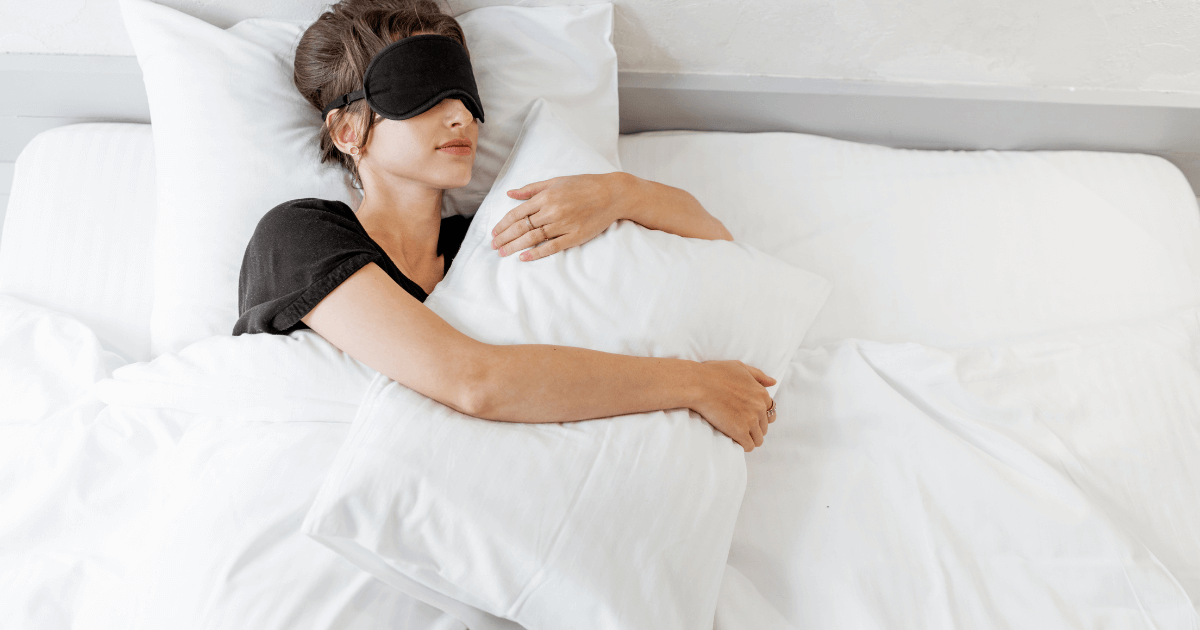The 6 Best Sleep Positions for Better Sleep (and Which to Avoid)

Your favorite sleep position might feel like a small detail, but it can shape everything from how your back feels in the morning to your mood, energy, and even long-term health. Most of us settle into the same position night after night, rarely thinking about whether it’s helping or hurting our bodies. With about 60% of adults saying they have trouble sleeping at least a few nights each week, the way you sleep could be an easy change that makes a big difference.
But what is the “best” position to sleep in? There’s really no single answer for everyone. It all depends on what your body needs and what health concerns you want to address, whether it’s snoring, acid reflux, back pain, or just better overall sleep.
Finding the Best Sleep Position for Your Body
Everyone’s sleep needs are unique, so your “best” position depends on your health and comfort. Sleep specialists agree that some positions tend to help more with certain problems. Here’s what you need to know about each one:
1. Side Sleeping (Especially on Your Left Side)
Best for: Reducing stomach acid, supporting pregnancy, minimizing snoring, and helping digestion.
Sleeping on your side is the most popular position for adults, and for good reason. There’s growing evidence that side sleeping can help with snoring, acid reflux, and even brain health.
Why left side?
Sleeping on your left side can be especially helpful for people with acid reflux or heartburn. Your stomach sits lower than your throat in this position, which makes it harder for acid to move upward.
For pregnant women, the benefits are even greater. The University of Auckland published research in The Journal of Physiology showing that sleeping on the left side can actually support better blood flow to the baby. Dr. Peter Stone, the lead researcher, explained,
“In the situation where the baby may not be healthy, such as those with poor growth, the baby may not tolerate the effect of maternal back sleeping. We are suggesting that there is now sufficient evidence to recommend mothers avoid sleeping on their back in late pregnancy.”
The research team used overnight sleep monitoring to track both mothers’ sleep positions and fetal activity. What they found was striking: when mothers slept on their backs, fetuses became noticeably less active, which is a key sign of well-being. But when mothers slept on their left or right side, the babies stayed more active and healthy.
Side sleeping also helps keep your airway open, which is important for people who snore. Studies have shown that side sleeping can reduce snoring by up to 50% because gravity helps keep the tongue and throat muscles from blocking the airway.
Drawbacks:
Some people find that side sleeping causes shoulder pain or lines on the face from pillow pressure. There can also be hip pain on a firm mattress.
How to make it better:
-
Place a pillow between your knees to keep your hips and spine lined up, which can ease lower back and hip pain.
-
Choose a pillow for your head that’s just thick enough to fill the space between your neck and the bed, keeping your neck straight and relaxed.
-
If you wake up with sore shoulders, try a softer pillow or mattress topper to relieve pressure.
2. Fetal Position (Relaxed Curl)
Best for: Relieving lower back pain, reducing snoring, and supporting brain health.
About 40% of adults naturally curl up in a fetal position at night. This position feels safe and comforting to many people, but it also has unique health benefits.
A study from Stony Brook University highlights how side sleeping in a fetal position might benefit your brain long-term. Dr. Helene Benveniste, who led the study, found that:
“The analysis showed us consistently that glymphatic transport was most efficient in the lateral position when compared to the supine or prone positions.”
What does this mean? The “glymphatic system” is the brain’s waste removal system. It clears out toxins and waste that build up during the day. Sleeping on your side, especially in a gentle curl, helps this system work better. This might lower the risk of developing brain-related illnesses like Alzheimer’s or Parkinson’s over time.
Dr. Maiken Nedergaard, another leading researcher in the study, adds,
“It is interesting that the lateral sleep position is already the most popular in humans and most animals—even in the wild—and it appears that we have adapted the lateral sleep position to most efficiently clear our brain of the metabolic waste products that build up while we are awake.”
The fetal position is also recommended for people with lower back pain, as it relaxes the spine and relieves tension.
Drawbacks:
Curling up too tightly can limit deep breathing and put more strain on your hips and shoulders.
How to make it better:
-
Keep your knees comfortably bent but not tucked tightly to your chest.
-
Use a pillow between your knees to keep your hips level and your lower back relaxed.
-
If you wake up with shoulder or hip pain, try loosening your curl or switching sides occasionally.
Also Read: The Connection Between Inflammation and Sleep Loss
3. Back Sleeping (Neutral Spine)
Best for: Keeping your spine aligned, reducing wrinkles on your face, and helping with acid reflux (if your head is slightly raised).
Sleeping on your back is sometimes called the “supine” position. This posture allows your body weight to spread out evenly and is one of the best ways to keep your spine and neck in a natural line. If you’re trying to prevent facial wrinkles, this is also the best position because your face doesn’t press against the pillow.
A controlled study published in WORK by Desouzart and colleagues found that back sleeping offers the most consistent support for the spine, especially in physically active seniors. The research showed
“a neutral position of the spine is generally considered optimal for spinal health, with back sleeping helping to maintain this alignment.”
Sleeping on your back can also help with acid reflux, as long as you keep your head slightly raised. One study in Digestive Diseases and Sciences found that sleeping on a wedge pillow reduced the amount of stomach acid that reached the esophagus.
Drawbacks:
Back sleeping isn’t ideal for everyone. If you snore or have sleep apnea (where breathing stops and starts during sleep), this position can make it worse. Gravity causes the tongue and soft tissues to fall back, narrowing your airway.
How to make it better:
-
Use a supportive pillow under your head, thick enough to keep your head slightly raised but not so high that it strains your neck.
-
Place a small pillow or rolled-up towel under your knees to support the curve of your lower back.
-
If you snore, consider combining back sleeping with a slightly inclined position.
4. Sleeping with Your Head Raised (Inclined Sleeping)
Best for: Reducing snoring, helping with breathing problems, and managing acid reflux.
Sleeping with your upper body raised, also known as “inclined sleeping,” can be very helpful for people who snore, have sleep apnea, or deal with acid reflux at night. Instead of lying flat, the upper body is elevated by 10 to 20 degrees using a wedge pillow or an adjustable bed.
A study published in JMIR Formative Research tested a 12-degree incline and found:
-
Snoring time was reduced by 7%
-
People woke up 4% less often
-
Deep sleep increased by 5%
The researchers concluded that:
“sleeping at an incline shows potential as a simple, non-invasive method to reduce snoring and improve sleep quality, particularly for people without clinical sleep disorders.”
Doctors often recommend inclined sleeping for people with both digestive and breathing issues. It might feel odd at first, but many people notice less snoring and deeper sleep after a week or two.
Drawbacks:
It can take time to adjust to sleeping on an incline, and some people find they slide down the bed during the night.
How to make it better:
-
Use a sturdy wedge pillow or an adjustable bed frame for support.
-
Make sure your pillow keeps your head and neck in a straight line with your spine.
-
Combine this position with side sleeping for extra comfort if needed.
5. Log Position (Straight Side Sleeping)
Best for: Keeping the spine straight, reducing pauses in breathing during sleep, and overall comfort.
If you sleep on your side with both arms and legs extended straight, you’re using the “log” position. This position is another good choice for keeping your spine aligned and reducing breathing problems like snoring or sleep apnea.
A survey by the Better Sleep Council in 2017 found that:
-
Log sleepers often describe themselves as healthy and well-rested.
-
This position is more common in men, and those who prefer it are also more likely to describe their mattress as “very comfortable.”
Sleeping in the log position can help prevent back pain if your mattress and pillow are supportive.
Drawbacks:
If your mattress is too firm, you may feel pressure on your hips or shoulders.
How to make it better:
-
Use a medium-firm mattress to support your body without causing pressure points.
-
Place a pillow between your knees for hip comfort and to keep your lower spine relaxed.
-
Alternate sides to avoid soreness on one side of your body.
6. Positions to Avoid: Sleeping on Your Stomach (Face Down)
Sleeping on your stomach is the least recommended by experts. While it may feel cozy, it often twists your neck to one side for breathing, which can strain your neck, shoulders, and lower back.
The only benefit? It sometimes reduces snoring, but at the cost of comfort and spinal health. Over time, stomach sleeping can lead to chronic neck pain and even numbness or tingling in the arms.
If you must:
-
Use the flattest, softest pillow possible—or none at all—to avoid extra strain on your neck.
-
Try putting a thin pillow under your hips to reduce pressure on your lower back.
-
If you want to transition away from stomach sleeping, try side sleeping with a body pillow to help you stay in position.
Also Read: This Common Habit Makes Insomnia Worse
When Changing Your Sleep Position Isn’t Enough
Even the best sleep position sometimes can’t help if your mind is racing or you’re feeling anxious at night. Many people struggle to relax and fall asleep, even when they’ve made their bed more comfortable or picked the perfect pillow.
This is where a gentle, plant-based sleep aid can make a real difference. Sip2Sleep® is specially designed with natural ingredients like Montmorency Tart Cherry, which is known to support your body’s melatonin production, and Rafuma Leaf, which has calming effects to help quiet your mind.
Unlike pills that can force sleep or make you groggy, Sip2Sleep® works with your body’s natural sleep-wake cycle. The liquid formula is taken under your tongue for quick absorption. You can use 1 to 3 full droppers, depending on what you need each night.
If you find yourself tossing and turning or worrying at bedtime, adding a gentle, natural sleep aid like Sip2Sleep® can help you relax so your body can get the rest it needs—no matter what sleep position you choose.
The Bottom Line
Choosing the best sleep position starts with understanding your body and your needs. There’s no perfect answer for everyone. For back pain, a relaxed fetal position or back sleeping with good support may be best. If you snore or have acid reflux, side sleeping or sleeping at an incline can make a real difference. What matters most is listening to your body and making small adjustments until you find what works.
And if changing your sleep position isn’t enough, consider combining good sleep habits with a natural sleep aid like Sip2Sleep® for complete support.
Common Questions About the Best Sleep Positions
Q: What is the best position to sleep in for most people?
A: Side sleeping, especially on the left, is considered best for most people because it supports healthy breathing and digestion and keeps your spine in good alignment.
Q: Which position helps with digestive issues or acid reflux?
A: Sleeping on your left side is recommended for people with acid reflux or digestive problems since it helps keep stomach acid from moving upward.
Q: Is there a position that prevents wrinkles?
A: Back sleeping is best for avoiding facial wrinkles, since your face isn’t pressed into a pillow.
Q: What about lower back pain?
A: A relaxed fetal position with a pillow between the knees often helps lower back pain. Some people also find relief sleeping on their back with a pillow under the knees.
References
-
The Physiological Society. "Sleep on your side, not your back in late pregnancy." ScienceDaily. ScienceDaily, 12 October 2017. <www.sciencedaily.com/releases/2017/10/171012091055.htm>
-
Stony Brook University. "Could body posture during sleep affect how your brain clears waste?" ScienceDaily. ScienceDaily, 4 August 2015. <www.sciencedaily.com/releases/2015/08/150804203440.htm>
-
Desouzart, G., Matos, R., Melo, F., & Filgueiras, E. (2016). Effects of sleeping position on back pain in physically active seniors: A controlled pilot study. WORK, 53(2), 235-240. https://doi.org/10.3233/WOR-152243
-
Jackson M, Collins A, Berlowitz D, Howard M, O'Donoghue F, Barnes M. Efficacy of sleep position modification to treat positional obstructive sleep apnea. Sleep Med. 2015 Apr;16(4):545-52. doi: 10.1016/j.sleep.2015.01.008.
-
Danoff-Burg S, Rus HM, Weaver MA, Raymann RJEM. Sleeping in an Inclined Position to Reduce Snoring and Improve Sleep: In-home Product Intervention Study. JMIR Form Res. 2022 Apr 6;6(4):e30102. doi: 10.2196/30102.
-
Hamilton JW, Boisen RJ, Yamamoto DT, Wagner JL, Reichelderfer M. Sleeping on a wedge diminishes exposure of the esophagus to refluxed acid. Dig Dis Sci. 1988 May;33(5):518-22. doi: 10.1007/BF01798350.
-
Menon A, Kumar M. Influence of body position on severity of obstructive sleep apnea: a systematic review. ISRN Otolaryngol. 2013 Oct 8;2013:670381. doi: 10.1155/2013/670381. PMID: 24223313; PMCID: PMC3817704.







